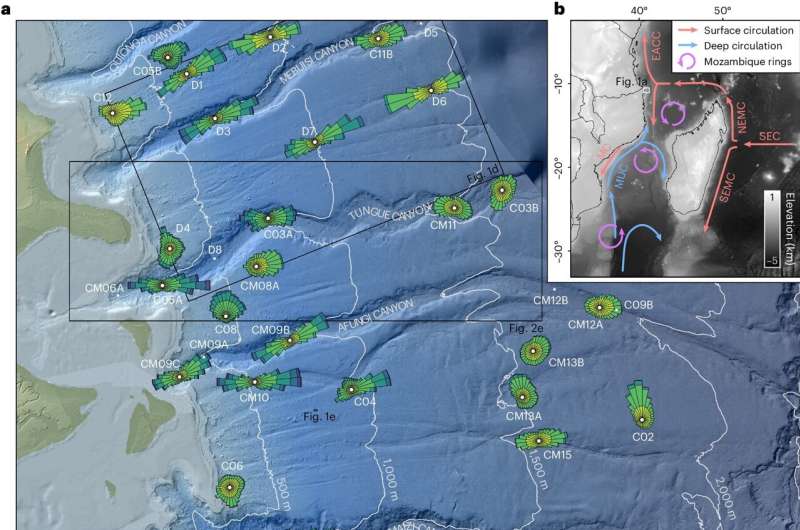This article has been reviewed according to Science X's editorial process and policies. Editors have highlighted the following attributes while ensuring the content's credibility:
fact-checked
peer-reviewed publication
trusted source
proofread
New study reveals new intricate behaviors of deep-sea currents

A new study has revealed that changes in the ocean floor impact currents, giving new insight into the deep-sea pathways of nutrients and pollutants.
The study, published in Nature Geoscience by scientists at the University of Manchester and led by the National Oceanography Center (NOC), has found that currents sped up, slowed down, changed direction, and sometimes reversed direction completely, depending on the varying and uneven surfaces and features found on the ocean floor.
Previous models suggested that these currents would be continuous and steady. These findings will help scientists to understand the deep-sea pathways of nutrients that sustain deep-sea ecosystems, as well as assess where microplastics and other pollutants accumulate in the ocean.
By better understanding how deep-sea currents interact with the seafloor, scientists can now more accurately interpret the deposits they leave behind. Those deposits act as long-term recorders of past climate change and can provide important clues about the potential impacts of future ocean changes.
The seafloor is the final destination for particles such as sand, mud, organic carbon that provides food for seafloor organisms, and even pollutants. Accumulations of these particles in the deep sea are used to reconstruct past climates, natural hazards and ocean conditions. This provides valuable archives of climate change that extends far beyond historical records.
The lead scientist on the project, Dr. Mike Clare of NOC, said, "It is important to understand the behavior and pathways of currents that operate in the deep sea, to determine pathways of natural and human-made particles. This information helps identify where pollution is coming from, which ecosystems it will interact with, and how to make sense of the records preserved in deposits.
"However, there have been very few direct measurements made of currents that flow across the seafloor in deep waters. Most are made high above the seafloor, over short timescales, and only at individual locations. Until now we have not understood how dynamic seafloor currents can be in the deep sea."
The new study, which involved researchers from the UK, Canada, Germany and Italy, analyzed data from an extensive array of sensors to determine the variability in seafloor currents over four years. Thirty-four deep sea moorings were deployed in up to 2.5 km water depths, equipped with high-frequency Acoustic Doppler Current Profilers—likened to an underwater speed camera that measures seafloor currents.
The study's lead author, Dr. Lewis Bailey, formerly of NOC and now at University of Calgary, said "The ocean bottom currents offshore Mozambique are far more variable than we expected. Just like currents in the upper ocean, their intensity changes between seasons and can even flip backwards and forwards over the course of several hours."
Dr. Ian Kane from the University of Manchester, and a co-author of the study, added, "Seeing how these currents behave is a bit like observing the weather in Manchester—always changing and often surprising. But observing change in the deep sea is really challenging and, until now, we have had a poor understanding of what background conditions are like in the deep-sea."
Professor Elda Miramontes from the University of Bremen, also a co-author of the study, said, "These are the first measurements of deep-sea currents across such a large area, long duration and so close to the seafloor. This makes them extremely valuable as they will help improve our models for reconstructing past changes related to climate change in the ocean."
Dr. Clare added, "The deep sea can be extremely dynamic and this study underlines the importance of sustained observations, which provide critical information on understanding the ocean. More detailed observations are critical for understanding the important role bottom currents play in transporting sediment, carbon and pollutants across our planet."
More information: Lewis P. Bailey et al, Highly variable deep-sea currents over tidal and seasonal timescales, Nature Geoscience (2024). DOI: 10.1038/s41561-024-01494-2
Journal information: Nature Geoscience
Provided by University of Manchester





















